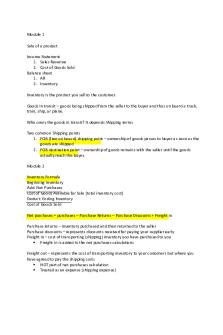Inventory Notes - Marc Smith PDF

| Title | Inventory Notes - Marc Smith |
|---|---|
| Course | Introduction to Accounting 1 |
| Institution | Ohio State University |
| Pages | 3 |
| File Size | 59.4 KB |
| File Type | |
| Total Downloads | 23 |
| Total Views | 149 |
Summary
Marc Smith...
Description
Module 1 Sale of a product Income Statement 1. Sales Revenue 2. Cost of Goods Sold Balance sheet 1. AR 2. Inventory Inventory Is the product you sell to the customer. Goods in transit – goods being shipped from the seller to the buyer and thus on board a truck, train, ship, or plane. Who owns the goods in transit? It depends Shipping terms Two common Shipping points 1. FOB (free on board) shipping point – ownership of goods passes to buyer as soon as the goods are shipped 2. FOB destination point – ownership of goods remains with the seller until the goods actually reach the buyer. Module 2 Inventory Formula Beginning Inventory Add: Net Purchases Cost of Goods Available for Sale (total inventory cost) Deduct: Ending Inventory Cost of Goods Sold Net purchases = purchases – Purchase Returns – Purchase Discounts + Freight in Purchase returns – inventory purchased and then returned to the seller Purchase discounts – represents discounts received for paying your supplier early Freight in – cost of transporting (shipping) inventory you have purchased to you Freight in is added in the net purchases calculations Freight out – represents the cost of transporting inventory to your customers but where you have agreed to pay the shipping costs NOT part of net purchases calculation Treated as an expense (shipping expense)
Inventory Cost Flow Models – used to calculate ending inventory on balance sheet and cost of goods sold on the income statement 1. FIFO 2. LIFO 3. Weighted Average (Average Cost) FIFO LIFO
assumes the oldest or earliest inventory items purchased are the first goods to be sold the cost of the oldest inventory items purchases make up the cost of goods sold on the income statement ending inventory consists of the cost of the most recent inventory items purchased
exact opposite assumes the most recent inventory items purchases are the first goods to be sold the cost of the most recent inventory items purchased make up the cost of goods sold on the income statement ending inventory consists of the cost of the oldest inventory items purchased Weighted Average all inventory items have the same cost Does not matter about old or new units Same cost is called the weighted average cost per unit (Cost of begin inventory + Cost of purchases) / units in begin inventory + units purchases Cost of goods available for sale / units available for sale All of these do not have to be consistent with the actual flow of goods Module 4 Ex: 1
Module 5 Inventory cost increasing over time (inflation) Highest NI? FIFO because inflation Old costs are the newest ones used Highest Total Assets? Newest most recent costs Highest inventory so highest assets Income Tax advantage? LIFO Highest expense so the lowest net income so the tax is the least Which shows ending inventory at the most current acquisition costs? FIFO (Always) Module 6
Ex: 1 Consistency principle – requires that companies use the same accounting methods period after period so the financial statements in succeeding periods will be comparable. Module 7 Ratios 1. Inventory Turnover Ratio a. Measures number of times on average the inventory is sold during a period b. COGS/Average inventory c. Average inventory = (Begin inventory + end inventory)/2 d. Measures how quickly sales are happening e. Higher is better 2. Number of days sales in inventory a. 365/Inventory Turnover b. Lower is better 3. Gross margin Rate (Gross Profit rate) a. Gross Profit/Net sales revenue b. Higher is better...
Similar Free PDFs

Inventory Notes - Marc Smith
- 3 Pages

Inventory Management Notes
- 60 Pages

ACLS Smith - notes
- 5 Pages

MARC Bloch
- 20 Pages

Notes ON Inventory Upload
- 40 Pages

Beck Depression Inventory Notes
- 3 Pages

Inventory
- 6 Pages

HRD Notes - Prof. Russell Smith
- 8 Pages

Smith chart - Lecture notes 1
- 1 Pages

Lecture Notes Ch. 9 Inventory
- 20 Pages

Adam Smith - Lecture notes 1
- 15 Pages

Marc Augè - Non Luoghi
- 6 Pages

Mamie and Bessie Smith - notes
- 6 Pages

NON Luoghi - Marc Augè
- 6 Pages

Inventory method
- 13 Pages
Popular Institutions
- Tinajero National High School - Annex
- Politeknik Caltex Riau
- Yokohama City University
- SGT University
- University of Al-Qadisiyah
- Divine Word College of Vigan
- Techniek College Rotterdam
- Universidade de Santiago
- Universiti Teknologi MARA Cawangan Johor Kampus Pasir Gudang
- Poltekkes Kemenkes Yogyakarta
- Baguio City National High School
- Colegio san marcos
- preparatoria uno
- Centro de Bachillerato Tecnológico Industrial y de Servicios No. 107
- Dalian Maritime University
- Quang Trung Secondary School
- Colegio Tecnológico en Informática
- Corporación Regional de Educación Superior
- Grupo CEDVA
- Dar Al Uloom University
- Centro de Estudios Preuniversitarios de la Universidad Nacional de Ingeniería
- 上智大学
- Aakash International School, Nuna Majara
- San Felipe Neri Catholic School
- Kang Chiao International School - New Taipei City
- Misamis Occidental National High School
- Institución Educativa Escuela Normal Juan Ladrilleros
- Kolehiyo ng Pantukan
- Batanes State College
- Instituto Continental
- Sekolah Menengah Kejuruan Kesehatan Kaltara (Tarakan)
- Colegio de La Inmaculada Concepcion - Cebu
